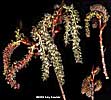
Trees of Wisconsin
|
Populus tremuloides Michx. quaking aspen Family: Salicaceae |
||||||||||||||
|
||||||||||||||
|
The leaves of Populus tremuloides are simple, alternate and toothed. The bark of young trunks is similar to the pale greenish white color of other members of this genus. When the trees reach a large size the older bark splits repeatedly and becomes furrowed and dark gray, although many stands are cut before they reach this stage. It lacks the whitish hairy buds of P. grandidentata and also lacks the long-pointed, resinous buds of P. balsamifera. In addition to the leaf shape, the darker buds and twigs of P. tremuloides distinguish it from P. deltoides. It is highly prone to spreading vegetatively by rhizomes (underground stems) and relatively large stands may be a single clone--the product of a single individual over a period of years. It also sprouts vigorously when cut and has covered many acres of northern Wisconsin with dense "doghair" stands following repeated clearcutting of forests. It is an important species for the papermaking industry. Populus tremuloides ranges from Alaska fully across Canada except for the northernmost portions and extends south to Iowa and New Jersey in the east and along the Rocky Mountains through the western states into northern Mexico. It is distributed throughout Wisconsin. It grows in a variety of soil conditions and dense stands following cutting are often accompanied by bracken fern (Pteridium aquilinum) and blackberries (and not much else) on sandy soils in the north. It is short-lived, does not tolerate shade and in the absence of disturbance it will be displaced by more shade tolerant species. |
|






